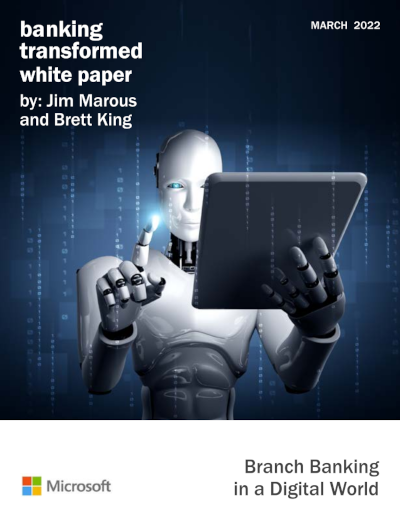Branch Banking in a Digital World
White Paper
Jim Marous & Brett King
March 2022
: DBR 292
26 pages, 13 tables/charts
Download Printable Version of this page
Financial institutions globally are redefining how customer experiences can be enhanced and channel engagement increased. The role of the branch is at the epicenter of this discussion, as organizations focus on creating tech-enabled, integrated ecosystems. Most importantly, banks and credit unions must support channel agnostic delivery where data and applied analytics allow a customer to determine when and where to engage without a change in service levels.
The exodus of customers using physical branches started way before the pandemic, with consumers in all age categories embracing digital alternatives to save time. While not all digital experiences have been simplified to the degree needed to compete with fintech and big tech players, the pandemic accelerated the trend away from physical engagement. This does not equate to the elimination of branches, but it does create the need to reimagine the future role of physical delivery.
Today, organizations have come to the realization that the consumer is looking for value in every level of engagement. In other words, most are willing to pay a bit more for an exceptional experience (this is why Amazon is able to charge over $100 for Amazon Prime). This has resulted in more financial institutions prioritizing the delivery of exceptional experiences.
Since most legacy financial institutions are not structured to become nimble digital players, many have opted to collaborate with either established fintech providers and/or third-party solution providers that can accelerate the digital transformation process and make existing branches more aligned with an omnichannel experience. By avoiding the ‘detours’ that can occur by building from scratch, banks and credit unions can become more agile and reduce costs as well. These collaborations can also help with the rethinking of back-office processes and operations that create barriers to delivering fast and easy digital solutions.
Technology, innovation, collaboration and a rethinking of legacy banking business models will all be required to achieve competitive differentiation in the future. There will be a continued (if not increased) threat of disruption from small fintech firms and the largest digital platform providers as the consumer demands even more from financial institutions. The question is: Will traditional financial institutions respond to these threats with the speed needed to succeed?
This white paper, sponsored by Microsoft, explores the future of branch delivery as a component of the overarching experience across the customer journey. This analysis uses insights collected from financial institutions globally combined with insights from third-party organizations. We are also very appreciative of the contribution from Brett King, who contributed valuable insights around the megatrends impacting branching today and in the future. The paper reveals the challenges and opportunities available with the building of an integrated delivery strategy as well as best practices in the industry.
Branch Banking in a Digital World
Advanced Analytics, AI, Analytics, Artificial Intelligence, Bank, Banking, Big Data, Credit Union, CRM, Customer Experience, Customer Engagement, Digital Banking, Digital Banking Transformation, Digital Lending, Digital Marketing, Digital Transformation, Engagement, Fintech, Innovation, Marketing, Mobile Banking, Payments, Personalization, Technology, Trends

